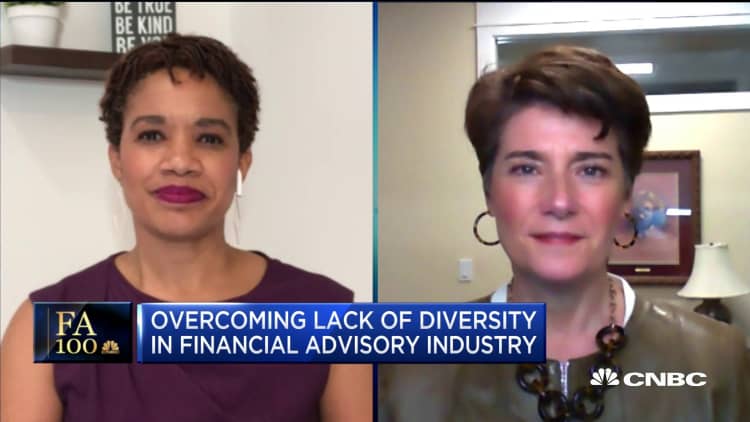
Martin Seay's term as president of the Financial Planning Association has, to say the least, been an eventful one so far.
Not only has the coronavirus pandemic changed just about everything in the advisory industry, but the Black Lives Matter movement and the nationwide protests that have followed the death of George Floyd at the hands of police in Minneapolis also present profound challenges to the White male-dominated financial advisory space.
Seay, a certified financial planner, is also Department Head and Associate Professor of Personal Financial Planning at Kansas State University.
More from FA 100:
CNBC ranks the top-rated advisor firms of 2020
Advisory firms turn to tech to help clients amid pandemic
Advisors adapt as pandemic changes connecting with clients
The FPA, with 20,000 members, and the broader advisory space are undertaking a candid examination of the industry's business incentives, hiring practices and work environments in terms of how they support the inclusion — or exclusion — of women and people of color.
To be sure, the scope of opportunities in the financial planning professional is quite broad and can be very rewarding. However, as varied as this profession is in the many types of job opportunities there are, the demographics of the industry do not reflect the diversity of the overall population.
There's obviously a great deal of work to be done. Just 3.8% of the industry's more than 87,000 advisors who hold the CFP designation are Black or Latino, according to the Certified Financial Planners board, the industry body which sets standards in financial planning. This compares with the approximately 20% of U.S. workers who identify as non-white or Latino, according to 2019 data from the U.S. Bureau of Labor Statistics.
What's more, overall less than 20% of advisors are women.
It is not an easy reckoning. Nor are there easy solutions to change that reality. CNBC spoke with Seay about the challenges of increasing diversity in the advisory industry.
CNBC: How diverse is the financial advisory industry?
Martin Seay: The numbers are pretty damning, when you look at them. Industry-wide, 82% of advisors are White and just 16% are women. Our numbers [at the FPA] are a bit better than industry average in terms of female CFPs (23%) but, at the end of 2019, just 3.8% of CFPs were Black or Latino. We want to see those numbers move up.
CNBC: How can the FPA help to increase those numbers?
Seay: Diversity is our challenge, and inclusion is the solution. We've been conducting listening tours with under-represented populations to understand the challenges they face with the intent to learn and take action. One individual shared a story with me about how her firm told her she had to change her name because they felt it was too ethnic.

It's one thing to recruit a person of color to your firm — that's critically important — but inclusion doesn't stop there. If we want to face the challenge of a lack of diversity, the solution is intentional inclusion and an awareness of that at many different levels. We have to make it clear in what we say and do that all people are welcome in this industry and that they can get the support they need to have a sustainable career path.
CNBC: As head of one of the premier financial planning departments in the country at Kansas State University, do you find it harder to pitch the idea of a financial planning career to students of color?
Seay: It is a challenge. It often has to do with experiences that many people have had with advisors in the past and their distrust of institutions more generally. It's hard to change those attitudes after people get to college.
In academia, we're now trying to influence the influencers like high school and college counselors to show this career path to students earlier. If firms and educational organizations aren't really intentional about this, we won't bring in more diverse candidates.
CNBC: Have any particular strategies worked in recruiting women and minority candidates at Kansas State?
Seay: We don't have it figured out yet. We have lots of things to learn about what works. For all students, we try to show them someone they could be in five years. We bring in successful advisors who look like them to show them that this is not just a hypothetical path but an achievable goal for them.
We all have to lean into this and use our voices to demand support for inclusion.Martin SeayPresident of the Financial Planning Association
Another thing that works is scholarships. It helps students go to college who otherwise might not be able to. But it also helps financial planning departments to leverage the whole recruiting process of a university. It activates a network of resources that amplifies the power of scholarships.
I applaud all efforts to start new programs and diversity initiatives in our industry, but I think it's critically important that we leverage existing structures rather than recreate the wheel.
CNBC: The advisory industry is notorious for its impatience with new hires to bring in business for firms. Are potential minority candidates to the profession particularly challenged by this incentive?
Seay: Recruitment of more diverse candidates to the industry is not the most important part of this issue. It's the success rate of those people who have started on this path. Facilitating their success creates opportunities for others behind them.
Our job is to leverage our networks to increase awareness of financial planning as a career and to help firms create sustainable career paths for people who can't bring in new business in year one. If the incentives in the industry don't change, it's going to be hard to do that.
CNBC: How do you see your own personal role in promoting diversity in the advisory industry?
Seay: I'm a White male from an upper-class family. What I think about this issue doesn't really matter. I'm just beginning to understand the challenges and opportunities for people in our industry. We haven't done everything right at the FPA, but we are very intentionally engaged on this issue and we want to rally the organization and its members to move the needle forward on this.
Something a colleague — Charles Adi, head of the FPA Diversity Committee — recently said to me really hit home. He said changes in our industry won't be driven by people of color alone. We need folks who look like me to speak loud and proud about the issue.
I struggle with it because it's not really in my nature. I'm passionate about the topic but I don't want to say the wrong thing. We need to show potential candidates to the profession the many success stories of people just like them that are out there, but we all have to lean into this and use our voices to demand support for inclusion.
Tune in to CNBC's "Power Lunch" at 2p ET today to see Evelyn Zohlen, 2020 Chair of the Financial Planning Association, and Lazetta Braxton, member of CNBC's FA Council and a CNBC Contributor, discuss the need for representative financial advice in communities of color.





